#1980s groceries
Text

Publix supermarket promotional photo, dated 1980
#grocery store#retro#soda#beverage aisle#80s fashion#Pepsi#Dr Pepper#Mountain Dew#7up#vintage#shopping#mom#kids#1980s groceries#pop#soft drinks
131 notes
·
View notes
Text


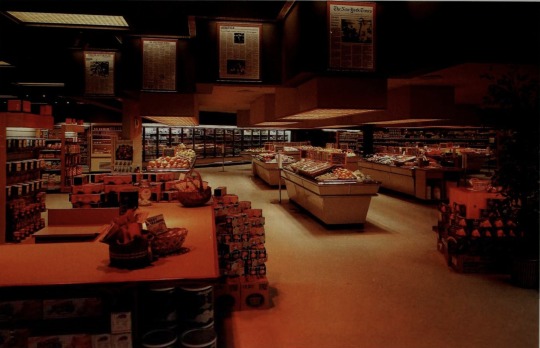

From Market, supermarket & hypermarket design by Pegler, Martin M
Source
160 notes
·
View notes
Text
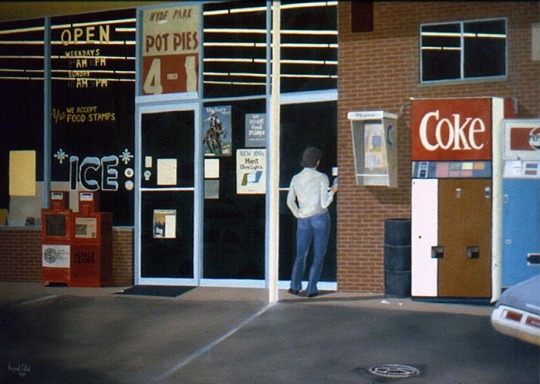
"Mullin’s Grocery", 1984 by Norman Engel
#norman engel#morehead kentucky#main street#old grocery store#1980s#oil painting#student work#sold#private collection
36 notes
·
View notes
Text
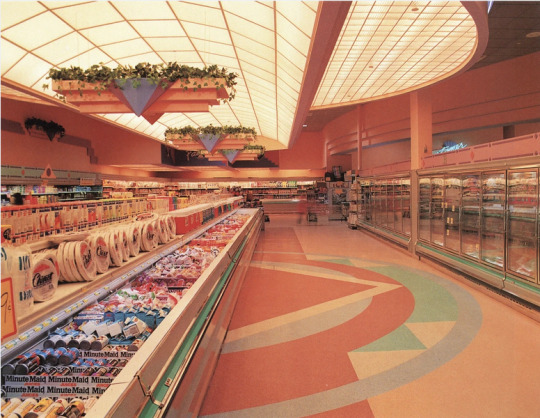
29 notes
·
View notes
Text
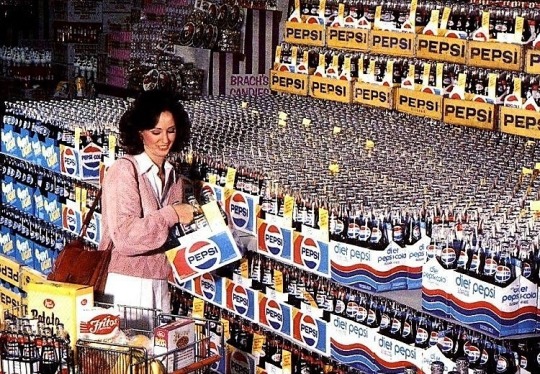
11 notes
·
View notes
Photo

Grocery Store, 1987
21 notes
·
View notes
Photo

Larry Hagman as J.R. Ewing from the television soap opera Dallas (1978-1991). [X]
#dallas#larry hagman#american television#television history#pop culture#1970s#1980s#1990s#i was grocery shopping today and while waiting in line#the cover of the latest tv guide had an advertise#‘the fondest tv memories’ with linda & larry from dallas in the background#i have been so close to post about dallas for the last two days#bc my sister & i have been talking about rewatching those legendary tv shows#(and bc you try to find a good pic from tumblr archive but there’s none u know)#so i guess i have to create one by myself#in that case it’s the one & only#the man in the grey suit & the stetson; the mf himself#j.r. ewing#🤠#own post
7 notes
·
View notes
Text

**KISSES THEM BOTH AND PICKS THEM BOTH UP OFF THE GROUND
#ot3: ❤rhyme💛easy💙#tape entry circa 1980#I WAS ABLE TO LIFT THEM BOTH UP OFF THE GROUND IN MY ARMS IN A DREAM SO THATS REAL NOW HFJDSK#i love them SOO SOOO SOO SO SO SO SOSOSOSOSO MUCH#every day i think of them and long for them#i just long for a happy life w them both... i want the simple things so badly tbh i want to fall asleep and wake up next to them every day#to make food for them and to cook together to go grocery shopping and running errands just whatever as long as its w them#there is beauty in everything even in the simple even in the ugly... and w them that beauty is so blindingly there at all times#i want to experience every little thing w them and be comforted by them and for them to comfort me too...#like when i broke the first elo album i ever owned and just BROKE down crying about it because of how important it was to me#and they went out immediately to try to find another first pressing to replace it#idk i just keep thinking about them and i keep feeling so sad because im not w them#the thought i could ever be w/o them makes me feel such deep dread that it makes me nauseous like ik i wouldnt be able to live w/o them#theyre my everything my life my loves my truest soulmates#id do anything to be home w them in the 80s to go on our rollerskating dates and to browse music for hours and hangout at the mall#idk i just cant stop thinking i just cant... i just love them more than life itself#i think everything in this world has beauty in it but when it comes to min and ryan its like nothing can even hold a candle to them#if the world is beautiful then they are ethereal#i was playing my guitar for a few hours today and just couldnt help but wonder if my min and ryan are proud of me...#if im... enough for them i guess#i havent been playing my whole life like they have so i feel like i cant match up... but ik they love me#and ik im good enough for the band and they would reassure me over and over of that#i just kinda wish they could love and reassure me in person#and then we could play and sing together :"-] id love to hear our voices together... i think my voice would go so perfectly w theirs
2 notes
·
View notes
Text
whoever is controlling the simulation, STOP sending the most immaculately dressed beautiful ppl out onto the streets when i’m dressed in leggings and a flannel
#SCREAMING CRYING AND PUNCHING AIR#I PROMISE I CAN DO BETTER I JUST LITERALLY HAVE A 30 SECOND WALK TO THE GROCERY STORE#AND ALL I NEED IS EGGS LIKE THERE WAS NO REASON TO PUT ON A WHOLE IMPECCABLE OUTFIT#BUT NOW I WISH I DID#passed a woman dressed in a 60’s dress with red heels and purse to match the red accents#and a guy who was dressed like he’s straight out of a 1980’s glam rock group#i was seething i hope my a*s at least looked good in the leggings 😔#talk time
4 notes
·
View notes
Text

Some Mobil service stations around Australia had larger stores bearing the name of Quix.
These lasted from possibly the late 1980s up to 2011 when the Mobil brand went dormant and most of its older (pre 2010s) locations nationwide were rebranded into 7-Eleven or On The Run (OTR).
#mobil#petrol#gas#gasoline#service station#petrol station#quix#food#store#shop#grocery store#convenience store#australia#australian#nostalgia#throwback#flashback#1980s#80s#1990s#90s#retro#rewind#childhood#memories#logo#logopedia
0 notes
Text

#wegmans#our best for less#vhs gif#vhs glitch#vhs#1980s aesthetic#1980s moticn graphics#grocery store
0 notes
Photo

grocery shopping, 1989
110 notes
·
View notes
Text
There's a chip shortage, if you believe the government. I don't: anyone can just head on down to their local grocery store and grab a big helping of Doritos. Wait, I guess those are out of stock. Tostitos, then? Nope, those too. Shit. Well, I can still get store brand.
Now, a lot of industrial analysts and professional "told-you-sos" are going to be really insufferable about this whole thing. They are going to tell us that they warned about the dangers of outsourcing our entire industrial production and way of life to a foreign country. And to that I say: it was cheaper this way.
There's still something that we can't outsource, though, and that's busted-ass shit piled up in our junkyards. It's our greatest resource. Foreign junkyards are too expensive to ship parts to us. In fact, foreign countries need our broken cars. They order barges full of them, so that they can melt them down and turn the constituent materials into useful stuff for normal people.
That's why I'm here today, speaking in my capacity as an amateur economist, urging us not to send our ruined cars away. If we can keep them all here, especially the critically important 1976 to 1980 Plymouth Volares and Dodge Aspens, then we can achieve self-reliance through the power of carburetors, Slant Sixes, and lean burn. No microchips needed, nor would they tolerate such a chaotic electrical environment. And mechanics, long idled by efficient modern cars, would get put back to work, installing semi-truck turbochargers from those very same junkyards onto our F-bodied daily drivers.
We used to be good at bad ideas. Now we're bad at good ideas. It's time to go back to being a bunch of degenerate greaseballs covering our lawns in the shattered wrecks of our proudest Malaise Era warm rods.
155 notes
·
View notes
Text
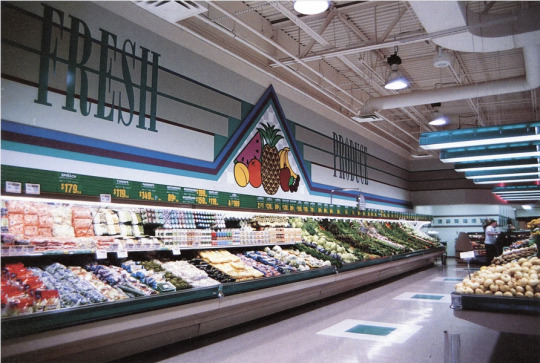
#liminal#cursed#liminal space#liminal spaces#liminalcore#grocery store#mall#1980s#1990s#childhood#reminds me SO much of somewhere we used to shop#i mean we still go there sometimes but it's all painted white now
25 notes
·
View notes
Text
WASHINGTON -- Inflation has changed the way many Americans shop. Now, those changes in consumer habits are helping bring down inflation.
Fed up with prices that remain about 19%, on average, above where they were before the pandemic, consumers are fighting back. In grocery stores, they're shifting away from name brands to store-brand items, switching to discount stores or simply buying fewer items like snacks or gourmet foods.
More Americans are buying used cars, too, rather than new, forcing some dealers to provide discounts on new cars again. But the growing consumer pushback to what critics condemn as price-gouging has been most evident with food as well as with consumer goods like paper towels and napkins.
In recent months, consumer resistance has led large food companies to respond by sharply slowing their price increases from the peaks of the past three years. This doesn't mean grocery prices will fall back to their levels of a few years ago, though with some items, including eggs, apples and milk, prices are below their peaks. But the milder increases in food prices should help further cool overall inflation, which is down sharply from a peak of 9.1% in 2022 to 3.1%.
Public frustration with prices has become a central issue in President Joe Biden’s bid for re-election. Polls show that despite the dramatic decline in inflation, many consumers are unhappy that prices remain so much higher than they were before inflation began accelerating in 2021.
Biden has echoed the criticism of many left-leaning economists that corporations jacked up their prices more than was needed to cover their own higher costs, allowing themselves to boost their profits. The White House has also attacked “shrinkflation,” whereby a company, rather than raising the price of a product, instead shrinks the amount inside the package. In a video released on Super Bowl Sunday, Biden denounced shrinkflation as a “rip-off.”
Consumer pushback against high prices suggests to many economists that inflation should further ease. That would make this bout of inflation markedly different from the debilitating price spikes of the 1970s and early 1980s, which took longer to defeat. When high inflation persists, consumers often develop an inflationary psychology: Ever-rising prices lead them to accelerate their purchases before costs rise further, a trend that can itself perpetuate inflation.
“That was the fear — that everybody would tolerate higher prices,” said Gregory Daco, chief economist at EY, a consulting firm, who notes that it hasn't happened. “I don't think we've moved into a high inflation regime.”
Instead, this time many consumers have reacted like Stuart Dryden, a commercial underwriter at a bank who lives in Arlington, Virginia. On a recent trip to his regular grocery store, Dryden, 37, pointed out big price disparities between Kraft Heinz-branded products and their store-label competitors, which he now favors.
Dryden, for example, loves cream cheese and bagels. A 12-ounce tub of Kraft's Philadelphia cream cheese costs $6.69. The store brand, he noted, is just $3.19.
A 24-pack of Kraft single cheese slices is $7.69; the store label, $2.99. And a 32-ounce Heinz ketchup bottle is $6.29, while the alternative is just $1.69. Similar gaps existed with mac-and-cheese and shredded cheese products.
“Just those five products together already cost nearly $30,” Dryden said. The alternatives were less than half that, he calculated, at about $13.
“I’ve been trying private-label options, and the quality is the same and it’s almost a no-brainer to switch from the products I used to buy a ton of to just the private label," Dryden said.
Alex Abraham, a spokesman for Kraft Heinz, said that its costs rose 3% in the final three months of last year but that the company raised its own prices only 1%.
“We are doing everything possible to find efficiencies in our factories and other parts of our business to offset and mitigate further price increases,” Abraham said.
Last week, Kraft Heinz said sales fell in the final three months of last year as more consumers traded down to cheaper brands.
Dryden has taken other steps to save money: A year ago, he moved into a new apartment after his previous landlord jacked up his rent by about 50%. His former apartment had been next to a relatively pricey grocery store, Whole Foods. Now, he shops at a nearby Amazon Fresh and has started visiting the discount grocer Aldi every couple of weeks.
Samuel Rines, an investment strategist at Corbu, says that PepsiCo, Kimberly-Clark, Procter & Gamble and many other consumer food and packaged goods companies exploited the rise in input costs stemming from supply-chain disruptions and Russia's invasion of Ukraine to dramatically raise their prices — and increase their profits — in 2021 and 2022.
A contributing factor was that millions of Americans enjoyed solid wage gains and received stimulus checks and other government aid, making it easier for them to pay the higher prices.
Still, some decried the phenomenon as “greedflation." And in a March 2023 research paper, the economist Isabella Weber at the University of Massachusetts, Amherst, referred to it as “seller's inflation.”
Yet beginning late last year, many of the same companies discovered that the strategy was no longer working. Most consumers have now long since spent the savings they built up during the pandemic.
Lower-income consumers, in particular, are running up credit card debt and falling behind on their payments. Americans overall are spending more cautiously. Daco notes that overall sales during the holiday shopping season were up just 4% — and most of it reflected higher prices rather than consumers actually buying more things.
As an example, Rines points to Unilever, which makes, among other items, Hellman's mayonnaise, Ben & Jerry's ice cream and Dove soaps. Unilever jacked up its prices 13.3% on average across its brands in 2022. Its sales volume fell 3.6% that year. In response, it raised prices just 2.8% last year; sales rose 1.8%.
“We're beginning to see the consumer no longer willing to take the higher pricing,” Rines said. “So companies were beginning to get a little bit more skeptical of their ability to just have price be the driver of their revenues. They had to have those volumes come back, and the consumer wasn’t reacting in a way that they were pleased with.”
Unilever itself recently attributed poor sales performance in Europe to “share losses to private labels.”
Other businesses have noticed, too. After their sales fell in the final three months of last year, PepsiCo executives signaled that this year they would rein in price increases and focus more on boosting sales.
“In 2024, we see ... normalization of the cost, normalization of inflation,” CEO Ramon Laguarta said. “So we see everything trending back to our long-term” pricing trends.
Jeffrey Harmening, CEO of General Mills, which makes Cheerios, Chex Cereal, Progresso soups and dozens of other brands, has acknowledged that his customers are increasingly seeking bargains.
And McDonald's executives have said that consumers with incomes below $45,000 are visiting less and spending less when they do visit and say the company plans to highlight its lower-priced items.
“Consumers are more wary — and weary — of pricing, and we’re going to continue to be consumer-led in our pricing decisions,” Ian Borden, the company's chief financial officer, told investors.
Officials at the Federal Reserve, the nation's primary inflation-fighting institution, have cited consumers' growing reluctance to pay high prices as a key reason why they expect inflation to fall steadily back to their 2% annual target.
“Firms are telling us that price sensitivity is very much higher now,” Mary Daly, president of the Federal Reserve Bank of San Francisco and a member of the Fed's interest-rate setting committee, said last week. “Consumers don't want to purchase unless they're seeing a 10% discount. ... This is a serious improvement in the role that consumers play in bridling inflation.”
Surveys by the Fed's regional banks have found that companies across all industries expect to impose smaller price increases this year. The New York Fed says companies in its region plan to raise prices an average of about 3% this year, down from about 5% in 2023 and as much as 7% to 9% in 2022.
Such trends suggest that companies were well on their way to slowing their price hikes before Biden's most recent attacks on price gouging.
Claudia Sahm, founder of SAHM Consulting and a former Fed economist, said, “consumers are more powerful than President Biden.”
33 notes
·
View notes
Text
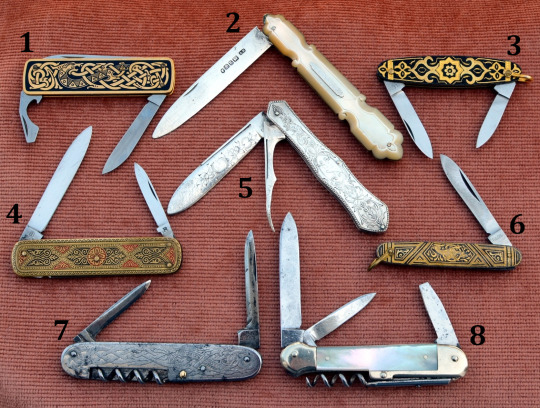
8 Fancy Pocket Knives
Etched pocket knife from Eskilstuna, Sweden
Silver / mother of pearl Victorian fruit knife, England
Damascene Toledo knife, Spain
Inlaid Toledo knife, Germany
Silver-plated fruit knife, USA
Damascene Toledo knife, Spain
Etched pocket knife from Eskilstuna, Sweden
Mother of pearl pocket knife from Eskilstuna, Sweden
@victoriansword [details after the cut]
1) Swedish pocket knife by EKA (Eskilstuna Kniffabriks AB), c. 1980-2000. Model 6 GS (1967-2010), with main blade, bottle opener/screwdriver, pen blade, and nail file. Tang stamp "EKA / SWEDEN" (from 1967), etched handle, 7 cm closed.
These were very popular in the 2nd half of the 20th century as gift knives or advertising knives. They were manufactured by many cutlers in Eskilstuna, and widely exported. The decorative pattern appears, with variations, on Swedish knives from at least the 19th century, and is inspired by Norse / Viking art, which often features twisted serpents/dragons. The interlacing perhaps also borrows from Celtic knots.
2) English fruit knife by Martin Bros & Co, 1848. Silver blade with 4 hallmarks (for Queen Victoria, the year, sterling silver, and Sheffield) and maker's mark, mother of pearl scales, 9.5 cm closed.
This is the posh version of what used to be an incredibly useful tool, a knife (and sometimes a multi-tool knife and fork) for eating on the road. The fancier ones were also status symbols, and very popular gifts – millions of silver fruit knives were manufactured in Britain from the 18th to the 20th century, mostly in Sheffield, Birmingham, and Edinburgh.
3) Spanish Toledo knife, as it's sometimes called, a damascened penknife of recent manufacture. Two pen blades, tang stamp "TOLEDO", 6.7 cm closed.
Not to be confused with Damascus blades! The handle is damascened – decorated with gold inlaid into oxidized steel (see here for details). Reminder that gold is a highly ductile metal (you can stretch it real thin before it breaks), so that impressive aesthetic result comes from a tiny amount of gold. It's a cheap knife, is what I'm saying, for tourists basically.
4) German pocket knife, confusingly also called Toledo, by Hartkopf. With main blade, pen blade and nail file. Brass handle inlaid with oxidised steel. Tang stamp "Hartkopf&Co / Solingen", 8cm closed.
It's "damascened" in the broad sense of inlaying, hence the name "Toledo": it supposedly emulates the Spanish style, and perhaps pretends to be Spanish, but both the metals and the geometric patterns are different. Knives of this type were popular in Germany all through the 20th century as gifts and advertising knives.
5) American fruit knife by William Rogers Mfg, made in Hartford, Connecticut c.1865-1898. Main blade, seedpick [also called nut-pick or nut-picker *snickers*], silver-plated nickel silver, decorated with flowers and apples. Tang stamp: an anchor logo and "Wm ROGERS & SON AA", 8.2 cm closed.
Sometimes fruit knives like this were bought by fruit shops/groceries (relatively fancy ones, presumably) in bulk, and sold or given to customers as gifts.
6) Spanish Toledo penknife (another one). With pen blade and damascened handle, different pattern, probably a bit older. Tang stamp again "TOLEDO", 6.8 cm closed.
7) Swedish pocket knife by Emil Olsson, c. 1920-1950. Blade, pen blade and corkscrew. Tang stamp "EMIL OLSSON / [star logo] / ESKILSTUNA", 9.2 cm closed.
Another etched serpent pattern on the handle, though by now you have to squint to see it. This knife has seen some shit. Until ~1940, pocket knives were widely sold and used in Sweden because they came with corkscrews, and all the bottles had corks, and everyone needed to open bottles. After the war, bottle caps replaced corks for everything except wine, and the pocket knife's utility plummeted, and cutleries started closing. There used to be hundreds, and by now only EKA's left. So statistically, if it's from before ~1950 it saw a lot of use, and if it's after ~1950 it did not, it was a gift or something.
8) Swedish pocket knife by EKA, c.1935-1965. Model 38 PB, with blade, pen blade, flat screwdriver, and corkscrew. Handle with mother of pearl scales and nickel silver bolsters, tang stamp "E.K.A. / ESKILSTUNA / SWEDEN", 8.3 cm closed.
The corkscrew is a quirky one, known as Gottlieb Hammesfahr patent: it pivots on the pin and opens perpendicular to the handle, not pulled downwards as in most pocket knives.
#tools of the trade#folding knife#sweden#sheffield#spain#germany#toledo#eskilstuna#solingen#usa#trs#trp#trc#how to stab#<- the knife nerd tag
23 notes
·
View notes